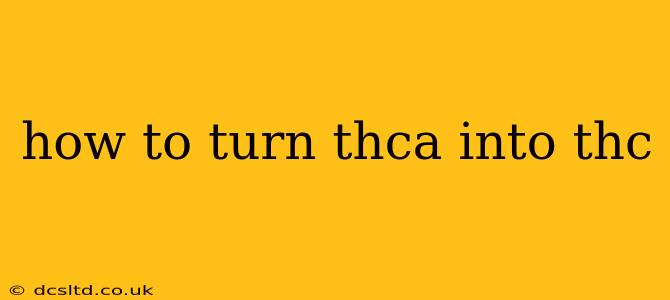Delta-9-tetrahydrocannabinol (THC) is the primary psychoactive compound in cannabis, responsible for the plant's euphoric effects. Tetrahydrocannabinolic acid (THCA) is the acidic precursor to THC. It's non-psychoactive in its raw form but readily converts to THC under the right conditions. This guide explains how to convert THCA into THC, focusing on the safety and legality of various methods.
Understanding the Conversion Process
The conversion of THCA to THC is a simple chemical reaction called decarboxylation. Heat triggers the removal of a carboxyl group (COOH) from the THCA molecule, leaving behind the THC molecule. This is the same process that naturally occurs when cannabis is cured or burned. However, the precise control afforded by specific methods allows for a more efficient and predictable conversion.
Methods for Decarboxylating THCA
Several methods can be used to decarboxylate THCA, each with its advantages and disadvantages:
1. Oven Decarboxylation:
This is the most common home method. It involves placing your THCA-rich material (such as kief or cannabis flower) in a low-temperature oven.
- Process: Preheat your oven to a temperature between 220-240°F (104-115°C). Spread the THCA material thinly on a baking sheet lined with parchment paper. Bake for 30-45 minutes, stirring halfway through. Monitor closely to prevent burning. The exact time and temperature will vary depending on the material and your oven.
- Advantages: Relatively simple and accessible.
- Disadvantages: Requires precise temperature control to avoid burning and wasted material. Inconsistent heating can lead to uneven decarboxylation.
2. Slow Cooker Decarboxylation:
This method offers more even heating than an oven.
- Process: Place your THCA material in the slow cooker on low heat for several hours (usually 4-6). Again, monitor closely to prevent burning. The specific time will depend on the slow cooker and the material.
- Advantages: More even heating than an oven, resulting in a more consistent product.
- Disadvantages: Requires longer processing times.
3. Sous Vide Decarboxylation:
This method provides highly precise temperature control, resulting in consistent decarboxylation.
- Process: Use a sous vide immersion circulator to maintain a specific temperature (around 220-240°F or 104-115°C) in a water bath. Seal your THCA material in a vacuum-sealed bag and submerge it in the water bath for the appropriate time.
- Advantages: Highly precise temperature control leads to consistent decarboxylation.
- Disadvantages: Requires specialized equipment (a sous vide immersion circulator and vacuum sealer).
Important Considerations:
How long does it take to decarboxylate THCA?
The decarboxylation time varies depending on the method and the temperature used. Generally, it takes between 30 minutes to several hours. Insufficient time will result in incomplete conversion, while excessive time and high temperatures can lead to degradation of the THC and other cannabinoids.
What temperature should I use to decarboxylate THCA?
The optimal temperature range is generally between 220-240°F (104-115°C). Going higher significantly increases the risk of burning and degradation.
What are the legal implications of converting THCA to THC?
The legality of converting THCA to THC depends heavily on your location. In many jurisdictions, possessing or processing THC is illegal, even if derived from THCA. Always check your local laws before attempting to decarboxylate THCA.
Safety Precautions:
Always work in a well-ventilated area. Avoid inhaling the fumes produced during the decarboxylation process. Use heat-resistant materials and follow safety guidelines for the chosen method.
Disclaimer: This information is for educational purposes only. The conversion of THCA to THC may be illegal in your jurisdiction. Always comply with local laws and regulations. This information does not constitute legal or medical advice.
